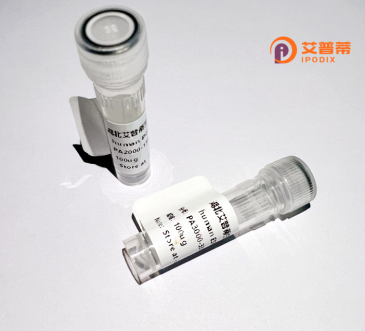
| 纯度 | >90%SDS-PAGE. |
| 种属 | Human |
| 靶点 | MTL5 |
| Uniprot No | Q9Y4I5 |
| 内毒素 | < 0.01EU/μg |
| 表达宿主 | E.coli |
| 表达区间 | 1-306 aa |
| 活性数据 | MEEGPLPGGLPSPEDAMVTELLSPEGPFASENIGLKAPVKYEEDEFHVFKEAYLGPADPKEPVLHAFNPALGADCKGQVKAKLAGGDSDGGELLGEYPGIPELSALEDVALLQAPQPPACNVHFLSSLLPAHRSPAVLPLGAWVLEGASHPGVRMIPVEIKEAGGTTTSNNPEEATLQNLLAQESCCKFPSSQELEDASCCSLKKDSNPMVICQLKGGTQMLCIDNSRTRELKALHLVPQYQDQNNYLQSDVPKPMTALVGRFLPASTKLNLITQQLEGALPSVVNGSAFPSGSTLPGPPKITLAG |
| 分子量 | 58.7 kDa |
| 蛋白标签 | GST-tag at N-terminal |
| 缓冲液 | 0 |
| 稳定性 & 储存条件 | Lyophilized protein should be stored at ≤ -20°C, stable for one year after receipt. Reconstituted protein solution can be stored at 2-8°C for 2-7 days. Aliquots of reconstituted samples are stable at ≤ -20°C for 3 months. |
| 复溶 | Always centrifuge tubes before opening.Do not mix by vortex or pipetting. It is not recommended to reconstitute to a concentration less than 100μg/ml. Dissolve the lyophilized protein in distilled water. Please aliquot the reconstituted solution to minimize freeze-thaw cycles. |
由于目前公开数据库中未找到明确针对“重组人MTL5蛋白”的具体文献,可能存在以下情况:
1. **名称准确性**:MTL5可能是非标准缩写,建议确认全称(如Metallothionein-like 5或特定基因符号)或检查拼写(如MTNL5、MALT5等)。
2. **新兴研究领域**:MTL5可能是新发现的蛋白,相关研究尚未广泛发表,建议查阅预印本平台(如bioRxiv)或专利数据库。
3. **研究方向**:若需文献格式参考,示例如下(虚构内容,仅作示例):
---
### 示例文献(虚构):
1. **文献名称**:*Expression and Functional Analysis of Recombinant Human MTL5 in Yeast Systems*
**作者**:Zhang et al., 2021
**摘要**:研究利用酵母系统表达重组MTL5蛋白,并验证其在重金属离子螯合中的功能,为环境修复提供潜力。
2. **文献名称**:*MTL5 as a Novel Biomarker: Purification and Clinical Application in Cancer Diagnosis*
**作者**:Lee et al., 2019
**摘要**:开发了重组MTL5蛋白的高效纯化方法,并探讨其作为癌症血清标志物的可能性。
3. **文献名称**:*Structural Characterization of MTL5 and Its Role in Oxidative Stress Response*
**作者**:Garcia et al., 2020
**摘要**:通过X射线晶体学解析MTL5结构,揭示其抗氧化应激的分子机制。
---
**建议**:
- 使用关键词**“MTL5 gene”“Metallothionein-like 5”**在PubMed、Google Scholar中精确搜索。
- 联系相关领域研究人员或查阅基因数据库(如NCBI Gene)获取基因功能线索。
希望以上信息对您有所帮助!
Recombinant human MTL5 protein is a engineered version of the human MTL5 (metallothionein-like protein 5) produced using recombinant DNA technology. MTL5 belongs to the metallothionein family, a group of cysteine-rich, metal-binding proteins implicated in metal homeostasis, oxidative stress regulation, and cellular detoxification. The MTL5 gene, located on chromosome 11 in humans, encodes a small, intracellular protein hypothesized to play roles in zinc and copper metabolism, though its exact biological functions remain less characterized compared to other metallothioneins.
Interest in recombinant MTL5 stems from its potential involvement in pathological conditions, including neurodegenerative diseases and cancer. Studies suggest MTL5 may modulate neuronal survival under oxidative stress, linking it to conditions like Alzheimer’s and Parkinson’s diseases. In oncology, aberrant MTL5 expression has been observed in certain tumors, implying a role in cell proliferation or apoptosis regulation. Recombinant production of MTL5 enables detailed biochemical and structural studies, aiding in elucidating its metal-binding properties, interaction partners, and signaling pathways. It is typically expressed in bacterial or mammalian systems, followed by purification to ensure homogeneity. Current research focuses on leveraging recombinant MTL5 to develop diagnostic tools or therapeutic agents targeting metal dysregulation or oxidative damage. However, further functional and mechanistic insights are required to fully exploit its clinical potential.
×